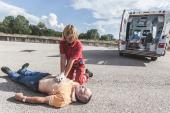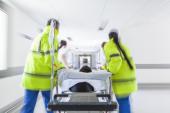Speedy Epinephrine Crucial in OHCA Patients
The drug’s greatest link to survival and function was seen in the first 5 minutes after EMS arrival, North American data show.

People who experience out-of-hospital cardiac arrest (OHCA) are most likely to live, and to do so with less disability, when they receive epinephrine within the first 5 minutes of emergency medical services (EMS) arrival on the scene, observational data indicate.
These associations, seen in a cohort of more than 40,000 North American patients, held true regardless of whether initial cardiac rhythm was shockable or nonshockable.
Both international and US guidelines currently support an early approach to epinephrine, researchers led by Masashi Okubo, MD (University of Pittsburgh School of Medicine, PA), point out in JAMA Network Open. They say their findings “provide further evidence to complement these [standards].”
In fact, their results indicate later epinephrine is linked to some harm, with both survival and function worsening minute-by-minute despite a simultaneous increase in the odds of return to spontaneous circulation (ROSC).
This isn’t the first study to suggest potential drawbacks to epinephrine in the OHCA setting. PARAMEDIC2, a randomized placebo-controlled trial published 3 years ago in the New England Journal of Medicine, showed a small increase in survival at 30 days, but at the expense of worse neurological impairment.
This discordance could be because “epinephrine increases brain injury in survivors,” suggest Jasmeet Soar, MB BChir (Southmead Hospital, North Bristol NHS Trust, Bristol, England), and Katherine M. Berg, MD (Beth Israel Deaconess Medical Center, Boston, MA), who wrote an editorial to accompany the current paper. But they raise another possibility: that epinephrine “helps achieve ROSC at a late stage of cardiac arrest when severe brain damage is more likely.”
Emergency physician Benjamin S. Abella, MD (University of Pennsylvania, Philadelphia), commenting on the new results for TCTMD, said that taken together the evidence suggests earlier is better with epinephrine, even if it’s not exactly clear why.
“This is the largest study to date that supports this concept that if we’re going to use epinephrine in cardiac arrest, it should be administered early,” he said, adding that the report helpfully provides data on the North American experience, while PARAMEDIC2 was conducted in Europe.
“And this is important because epinephrine has been a cornerstone of cardiac arrest therapy for decades, but the data on it are very mixed and very unclear,” Abella continued. Timing could be an explanation for this variability across studies, he said.
Shockable, Nonshockable Both Benefit
For their cohort study, Okubo et al used patient-level data from the Resuscitation Outcomes Consortium Cardiac Epidemiologic Registry, conducted at 10 regional coordinating sites across North America. They identified 41,079 people (median age 67 years; 64.7% men) with EMS-treated nontraumatic OHCA between April 2011 and June 2015.
One-quarter initially had shockable cardiac rhythm (ventricular defibrillation or pulseless ventricular tachycardia) and three-quarters had nonshockable (pulseless electrical activity or asystole). Epinephrine was given to 81.5% and 90% of these groups, respectively, with median times between EMS arrival and epinephrine use of 7.3 minutes and 8.1 minutes.
The fact that we’re still studying epinephrine 30-40 years after it was first put to use for resuscitation suggests that we need other agents. Benjamin S. Abella
With shockable rhythm, administration of epinephrine wasn’t associated with greater survival to discharge on the whole, nor was it linked to favorable functional outcome (modified Rankin Scale score of ≤ 3). There was, however, an increase in prehospital ROSC (RR 1.16; 95% CI 1.12-1.21) with epinephrine therapy. Still, survival to hospital discharge was highest—but nonsignificantly so—when epinephrine was administered within 5 minutes after EMS arrival (risk ratio [RR] 1.12; 95% CI 0.99-1.26). Analyzed with timing as a continuous variable, each minute after EMS arrival decreased the odds of survival to discharge by 5.5% and functional outcome by 6.4%. Meanwhile, the odds of ROSC rose by 1.4%.
With nonshockable rhythm, the patterns were similar for epinephrine, again showing only an improvement in prehospital ROSC (RR 1.35; 95% CI 1.31-1.40) and the strongest association with survival within the first 5 minutes (RR 1.28; 95% CI 0.95-1.79). With each minute after EMS arrival, survival dropped by 4.4% and functional outcome by 7.1%, while prehospital ROSC increased by 1.5%.
Thus, “for both initial shockable and nonshockable cardiac rhythms, we found that the associations of epinephrine administration with survival to hospital discharge and favorable functional status at hospital discharge differed on the basis of the timing of administration,” with decreasing returns over time, the investigators conclude.
No Easy Answer
Abella said that these rapidly unfolding scenarios aren’t unique to epinephrine but seen “for many therapies in resuscitation science and cardiac arrest care, because things are just so time-sensitive. We know that the chance of surviving cardiac arrest falls by 10 to 15% for every minute without CPR provision, and so a similar curve may be present for time to epinephrine delivery as well.”
That said, the mechanism in this instance isn’t clear. “We have a general understanding of how epinephrine works biologically, in that it has stimulant effects on the heart, chronotropic and inotropic effects,” Abella explained. “But specifically to improve the chance of getting someone’s pulse back? We really don’t fully know how it works. Nor do we fully understand how it should be dosed.”
The study’s message is less complicated. “If paramedics are able to establish IV access, they should give epinephrine right away,” he stressed. “But this is often practically difficult, because the call goes to 9-1-1, people have to get there, they have to assess the patient, [and] they have to place an IV. So it’s not always as easy as it sounds.”
With delays, the medication’s benefits are lessened, Abella said. “I think that’s largely because at some point a patient without blood flow is just so injured . . . that not much can rescue them.”
Even if they survive, their neurologic function may be poor when epinephrine is given late. Making a decision about the risk-benefit trade-off in this situation “is challenging,” he observed, “because of course in the heat of the moment a comatose cardiac arrest patient can’t be asked what they would want, and paramedics just have to err on the side of saving someone’s life if they can.”
Overall, there’s a long way to go in terms of developing pharmacologic options in this arena, said Abella. While epinephrine can be useful, “the fact that we’re still studying epinephrine 30-40 years after it was first put to use for resuscitation suggests that we need other agents. We need the help of the pharmaceutical industry to consider other medications,” he concluded, “because it’s clear epinephrine is not going to be our rescue agent to save lives.”
Caitlin E. Cox is News Editor of TCTMD and Associate Director, Editorial Content at the Cardiovascular Research Foundation. She produces the…
Read Full BioSources
Okubo M, Komukai S, Callaway CW, Izawa J. Association of timing of epinephrine administration with outcomes in adults with out-of-hospital cardiac arrest. JAMA Network Open. 2021;4(8):e2120176.
Soar J, Berg KM. Early epinephrine administration for cardiac arrest. JAMA Network Open. 2021;4(8):e2120725.
Disclosures
- Okubo and Abella report no relevant conflicts of interest.
- Soar reports serving as the current chair of the International Liaison Committee on Resuscitation Advanced Life Support (ALS) Task Force, chair (science) of the European Resuscitation Council ALS Science and Education Committee, and a member of the PARAMEDIC2 data monitoring committee, as well as receiving payments from Elsevier for work as editor of the journal Resuscitation.
- Berg serves as the vice chair of the International Liaison Committee on Resuscitation ALS Task Force and vice chair of the American Heart Association Adult Basic Life Support and ALS Guidelines Writing Group and is supported by a grant from the National Heart, Lung, and Blood Institute.





Comments